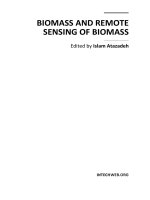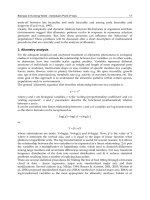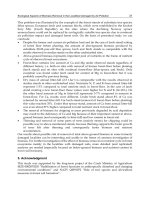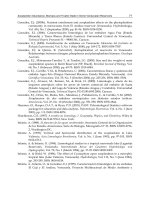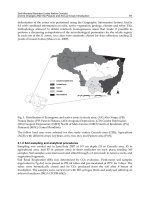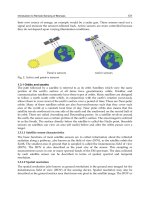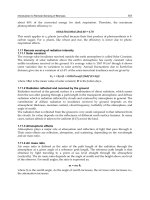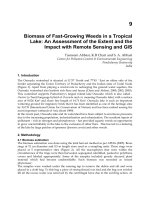Biomass and Remote Sensing of Biomass Part 12 pdf
Bạn đang xem bản rút gọn của tài liệu. Xem và tải ngay bản đầy đủ của tài liệu tại đây (593.46 KB, 20 trang )
A Comparative Study of Carbon Sequestration Potential
in Aboveground Biomass in Primary Forest and Secondary Forest, Khao Yai National Park
211
Forest Research. (2011). Kyoto Protocol and UK forests, Climate Change Mitigation, Available
from />62VEK3.
Gibbs, H.K., Brown, S., Niles, J.O., & Foley, J.A. (2007). Monitoring and Estimating Tropical
Forest Carbon Stocks: Making REED a Reality, Environ. Res. Lett. Vol. 2, pp. 1 – 13.
Gorte, R.W. (2009). Carbon Sequestration in Forests. CRS Report for Congress, Congressional
Research Service, August 6, 2009.
Iversion, L. R., Brown, S., Prasad, A., Mitasova, H., Gillespie, A.J.R. & Lugo, A.E. (1994). Use
of GIS Estimating Potential and Actual Forest Biomass for Continental South and
Southeast Asia. In W. Dale, (Ed.), Effect of Land-Use Change on Atmospheric CO
2
Concen-tration, Springer - Verlag, New York, pp 67 – 116.
Kekule, L.B. (2009). Khao Yai: Thailand’s First and Most Famous National Park. In: Bangkok
Post, August 31, 2009, Available from />world-heritage-treasure-in-the-north-east/
Lasco, R.D. (2002). Forest Carbon Budgets in Southeast Asia following Harvesting and Land
Cover Change, Science inChina Vol. 45, pp. 55–64.
Leith, H.F.H. (1975). Primary Productivity in Ecosystems: Comparative Analysis of Global
Patterns. In W.H. Van Dobben & R. H. McConnell, (Eds.), Unifying Concepts in
Ecology, The Huge, Wageningen, pp 67 – 87.
Mackey, R.L. & Currie, D. (2001). The Diversity – Disturbance Relationship: Is It Generally
Strong and Peaked?, Ecology Vol 82(12), pp. 3479-3492.
Malhi, Y., Wood, D., Bakers, T.R., Wright, J., Phillips, O.L., Cochrane, T., Meir, P., Chave, J.,
Almeida, S., Arroyo, L., Higuchiss, N., Killeen, T.J., Laurance, S.G., Laurance, W.F.,
Lewiss, S.L., Monteagudo, A., Neill, D.A., Vargas, P.N., Pitman, N.C.A., Quesadas,
C.A., Salomao, R., Silva, J.N.M., Lezama, A.T., Terborgh, J., Martinez, R.V. &
Vinceti, B. (2006). The Regional Variation of Aboveground Live Biomass in Old-
Growth Amazonian Forests, Global Change Biology Vol 12, pp. 1-32.
Mani, S. & Parthasarathy, N. (2007). Above-ground biomass estimation in ten tropical dry
every forest sites of peninsular India, Biomass and Bioenergy, Vol 31, pp. 284-290.
Michaelowa, A. & Rolfe, C. (2001). Early Action to Reduce Greenhouse Gas Emissions before
the Commitment Period of the Kyoto protocol: Advantages and Disadvantages,
Environmental Management Vol 28, pp. 281–292.
Ogawa, H. 1969. An attempt at classifying forest types based on the relationship between
tree height and DBH. In T. Kira (ed.), Comparative study of primary productivity of
forest ecosystem, pp. 3 – 17.
Ogawa, H., Yoda, K. & Kira, T. (1961). A Preliminary Survey on the Vegetation of Thailand,
Natural and Life in Southeast Asia Vol 1, pp. 21–157.
Ogawa, H., Yoda, K., Ogino, K. & Kira, T. (1965). Comparative Ecological Studies on Three
Main Type of Forest Vegetation in Thailand II. Plant Biomass, Nature and Life in
Southeast Asia Vol 4, pp. 49 - 80.
Mackey, R.L. & Currie, D.J. (2001). The Diversity – Disturbance Relationship: Is It Generally
Strong and Peaked?, Ecology Vol. 82 (12), pp. 3479-3492.
Sahunalu, P., Chamreanpruk, M., Puriyakorn, B., Dhanmanonda, P., Suwannapin, W. &
Prachaiyo, B. 1979. Structure of three forest types in the Prom Basin, Chaiyaphum
Province. Faculty of Forestry: Kasetsart University.
Biomass and Remote Sensing of Biomass
212
Terakunpisut , J., Gajaseni, N. & Ruankawe, N. (2007). Carbon Sequestration Potential in
Aboveground Biomass of Thong Pha Phum National Forest, Thailand, Applied
Ecology and Environmental Research Vol.2, pp. 93-102, ISSN 1589-1623
Tsutsumi, T., Yoda, K., Sahunalu, P., Dhanmanonda, P. & Prachaiyo, B. (1983). Forest:
Felling, Burning and Regeneration, In K. Kyuma & C. Pairintra, (Eds.), Shifting
cultivation, Tokyo, pp. 13-62.
UNCTAD secretariat. (n.d.). Trends in Tropical Forest Area. Tropical Timber [Online],
Available from
UNFCCC. 1997. Kyoto Protocol to the United Nations Framework Convention on Climate Change
Available from:
index.html
Whittaker, R.H. (1970). Communities and Ecosystem, Toranto, Macmillian.
Yamakura, T., Hagihara, A., Sukardjo, S. & Ogawa, H. (1986). Aboveground biomass of
tropical rain forest stands in Indonesian Borneo, Plant Ecology Vol. 68 (2), pp. 71-82.
12
Carbon Storage in Cold Temperate
Ecosystems in Southern
Patagonia, Argentina
Pablo Luis Peri
Universidad Nacional de la Patagonia Austral (UNPA)- Instituto Nacional
de Tecnología Agropecuaria (INTA) EEA Santa Cruz-CONICET
Argentina
1. Introduction
Recently there has been an increasing interest of research related to improve the
understanding of carbon (C) sequestration mainly under Article 3.4 of the Kyoto Protocol of
the United Nations Framework Convention on Climate Change where countries can count
this sequestration as a contribution to reduce greenhouse gas emission (IPCC, 2001). Data on
C storage in forests, grasslands and shrublands are essential for understanding the
importance of rapidly increasing level of CO
2
in the atmosphere and its potential effect on
global climate change. In South America, mean annual temperature is predicted to increase
by 3-4 °C in both summer and winter between 30° and 55° SL (Manabe & Wetherald, 1987).
Such an increase would have significant effects on Patagonian ecosystems. In this context,
secondary indigenous forests are considered efficient C sink ecosystems. Nothofagus
antarctica (ñire), one of the main deciduous native species in the Patagonian region
(Argentina), covers 751.643 hectares over a wide latitudinal (from 36° 25' to 54° 53' SL) and
altitudinal (near sea level to 2000 m.a.s.l.) distribution. These forests occur naturally in
different habitats such as poorly drained sites at low elevations, exposed windy areas with
shallow soils, depressions under cold air influence, or in drier eastern sites near the
Patagonian steppe (Veblen et al., 1996). These forests provide a range of wood products
including poles, firewood and timber for rural construction purposes. Site quality for N.
antarctica ranges from tall trees up to 15 m in dominant height on the best sites to shrubby
trees of 2 m tall on rocky, xeric and exposed sites, and also in poorly drained sites. Previous
research has highlighted the importance of stand age on the magnitude of C pools in both
forest biomass and forest floor pools (Silvester & Orchard, 1999; Davis et al., 2003). Large-
scale canopy disturbance in N. antarctica forests may occur as a result of blowdown, snow
avalanches or fire. This results in abundant regeneration (100,000 seedlings ha
-1
less than 1
m tall, up to 20 years of age) followed by self thinning due mainly to light competition
resulting in a final stand density of 200-350 trees ha
-1
at mature stages (more than 180 years
of age). It is important to emphasize that many researchers have only focused on above-
ground carbon sequestration (Davis et al., 2003). However, roots in forest ecosystems can
contribute up to two times more biomass than above-ground components in young growth
phases (Peri et al., 2006, 2008). There are few studies of above- and below-ground pools of C
Biomass and Remote Sensing of Biomass
214
storage in Patagonian Nothofagus forests that provide an understanding about ecosystem
functionality (Peri et al., 2004, 2005) and the consequences of different disturbance and
management regimes. In this context, forest ecosystem pools and fluxes of C are strongly
affected by forest management (Finér et al., 2003). Peri et al. (2010) showed that C storage in
tree components (leaves, stems, branches, roots) and forest floor change as a result of
different forest structure determined by the proportion of crown classes, development
stages (age) and the site quality where trees grow.
The steppe ecosystem, mainly characterised by the presence of tussock, short grasses and
shrubs, covers 85% of the total area. Grazing has modified the structure of Patagonian
ecosystems by reducing vegetation cover, increasing bare areas, and changing floristic
composition. Erosion and degradation processes have occurred in several areas of Patagonia
due to an overestimation of the carrying capacity of these rangelands, inadequate
distribution of animals in very large and heterogeneous paddocks, and year-long
continuous grazing (Golluscio et al., 1998). In Patagonia, most of the actual knowledge about
the environmental factors that affect net primary production of grasslands at regional level
derives from the importance of mean annual precipitation, radiation and temperature
(Jobbágy & Sala, 2000). However, data on C accumulation in both above- and belowground
components of plant functional types are essential for evaluating the impacts of grazing on
C cycle and long -term effects on the C balance of grasslands. Global estimates of the relative
amounts of C in different vegetation types suggest that grasslands approximately contribute
more than 10% of the total biosphere store (Nosberger et al., 2000). Also, it has been
demonstrated that most temperate grasslands under existing management conditions are
considered to be C sink and sequester more C than arable crops (Connan et al., 2001).
Therefore, the aim of this manuscript was to describe the amount of C in both above- and
below-ground components for the main cold temperate ecosystems in Southern Patagonia
(Argentina). In particular, the aim was to quantify the C storage in an age sequence and
among crown classes for individual trees grown at different site qualities of deciduous N.
antarctica forests in Southern Patagonia and under silvopastoral use, and to quantify the
amount of C for main grassland steppe ecosystems including the effect of grazing.
2. Carbon storage in main Patagonian ecosystems
2.1 Nothofagus antarctica native forest
Above- and below-ground C pools were measured in pure even-aged stands of Nothofagus
antarctica at different ages (5 to 220 years), crown (dominant, codominant, intermediate,
suppressed) and site (site class III (SC III) where the mean total height of dominant mature
tree (H) reached 10.2 m, site class IV (SC IV) where H reached 7.8 m, and site class V (SC V)
which represented a marginal site where H reached 5.3 m) classes in the Patagonian region
(Peri et al., 2010). Mean tissue C concentration varied from 46.3% in medium sized roots of
dominant trees to 56.1% in rotten wood for trees grown in low quality sites. Total C
concentration was in the order of: heartwood > rotten wood > sapwood > bark > small
branches > coarse roots > leaves > medium roots > fine roots.
Sigmoid functions were fitted for total C accumulation and C root/shoot ratio of individual
trees against age for each site class. The parameters are given in Peri et al. (2010). Total C
accumulation over time followed the order: dominant > codominant > intermediate >
suppressed trees (Fig. 1a). For example, dominant trees growing on SC III had accumulated
228 kg C tree
-1
after 180 years and suppressed trees only 46 kg C tree
-1
. Also, site quality of
Carbon Storage in Cold Temperate Ecosystems in Southern Patagonia, Argentina
215
the stands had a strong impact on total C accumulation over time. For example, while the
mean total C accumulated for dominant trees grown in SC V at 150 years was 109 kg C tree
-
1
, dominant trees growing on SC III had 207 kg C tree
-1
. C accumulation was divided by tree
age to establish the average annual rate at which C was accumulated by trees. The rate of C
accumulation showed a parabolic relationship with tree age and increased to reach a
maximum and then declined as tree age increased further (Fig. 1b). Crown class also
affected the maximum value and shape of this response. For example, maximum
accumulation rate for dominant trees growing on SC III was 1.44 kg C tree
-1
year
-1
at 116
years and then declined to 1.10 kg C tree
-1
year
-1
at 220 years (Fig. 1b). In contrast, maximum
accumulation rate for suppressed trees was 0.26 kg C tree
-1
year
-1
at 139 years (Fig. 1b). Also,
the site quality modified the maximum values and the shape of the rate of C accumulation.
The greater C accumulation of dominant trees at any age compared to inferior crown classes
was very closely related to the C accumulation rates. This is consistent with Rötzer et al.
(2009) who estimated that the amount of C storage in both above- and belowground
components over time for a mixed beech stand changed with variations in site conditions,
especially when precipitation decreased. Dominant trees and trees growing in better site
qualities had larger crowns with more biomass of photosynthetic green leaves, and
consequently had faster growth rates. In contrast, the leaves of suppressed trees located in
the inferior stratum receive less available light for photosynthesis and these less active
leaves may accumulate less C. For N. antarctica trees, there were no significant difference in
the slope of the relationship between the C root/shoot ratio and age for different crown
classes. Therefore, a single function was used for each site quality class. C root/shoot ratio
decreased with age from a maximum value to a steady-state asymptote value. For example,
C root/shoot ratio decreased from maximum values of 1.3 at 5 years to a steady-state
asymptote of 0.3 beyond 60 years of age, for trees grown in SC III (Fig. 1c).Thus, root C
accumulation was greater during the regeneration phase, and then the above-ground C
accumulation of young and mature trees increased over time. The above-ground C content
for N. antarctica was lower than values reported by Hart et al. (2003) for an even-aged N.
truncata old growth forest (root/shoot ratio of 0.28). At any time, the root C accumulation
was greater for trees growing on the poorer sites (SC V) than for better site conditions. It has
been demonstrated that N. antarctica has more root biomass to ensure establishment during
stand replacement to improve water and nutrient uptake in dry environments and to
provide better support in windy sites with shallow soils, compared to other Nothofagus
species (Gargaglione et al., 2010).
In primary N. antarctica forest there were no significant differences in soil C pools for
different age classes (data not shown). This is consistent with Davis et al. (2003) who
reported that the sum of forest floor and mineral soil C in a New Zealand Nothofagus forest
did not differ with age. However, total C content in the soil profile varied according to the
site quality from 87.7 to 198.8 Mg C ha
-1
for SC V and SC III, respectively (Table 1). Soil C
concentration increased from SC V to SC III thus influencing C content in organic and
inorganic horizons (Table 1). The C content of litter, organic-layer and inorganic soil layers
were greater in the best site quality class stands. The C in the soil pool (Table 1) represents
between 52% (optimal growth phase stand grown at SC IV) and 73% (mature phase stand
grown at SC III) of total ecosystem C. The soil C pool estimated in the present work was
greater than those reported for other Nothofagus species (Tate et al., 1993; Hart et al., 2003)
and similar to native cypress forests in Patagonia (Laclau, 2003). This highlights the
importance to quantify the variability in soil C storage among forest types.
Biomass and Remote Sensing of Biomass
216
Age (years)
0 50 100 150 200 250
Carbon acumulation (kg C tree
-1
)
0
50
100
150
200
250
300
(a)
Age (years)
0 50 100 150 200 250
Carbon accumulation rate (kg C tree
-1
year
-1
)
0.0
0.2
0.4
0.6
0.8
1.0
1.2
1.4
Dom
Cod
Int
Sup
(b)
Age (years)
0 50 100 150 200 250
C root/shoot ratio (dimensionless)
0.0
0.5
1.0
1.5
2.0
2.5
(c)
Fig. 1. Total carbon (C) accumulation (a), C accumulation rates (b) and C root/shoot ratio (c)
against age for different crown classes of N. antarctica trees growing at Site Class III (mean
total height of dominant mature tree 10.2 m) in south Patagonia, Argentina (Peri et al., 2010).
Carbon Storage in Cold Temperate Ecosystems in Southern Patagonia, Argentina
217
The equations for total C accumulation from individual trees were used to estimate the C
storage at the stand level using forest inventory data. Total C storage in N. antarctica forest
ranged from 40.3 Mg C ha
-1
for mature stands grown at SC V to 182.0 Mg C ha
-1
for optimal
growth stands at SC III (Table 1). In all studied site quality classes, total C accumulation was
greater at the development stage of optimal growth (21-110 years). Similarly, Davis et al. (2003)
estimated that stem C storage in N. solandri var. cliffortiodes forest in a montane zone of New
Zealand reached a maximum value (137 Mg C ha
-1
) at the pole development stage (120 years).
In contrast, Laclau (2003) reported that C storage of native cypress forest in northwest
Patagonia did not change significantly with stand age and precipitation (site quality).
Sapwood contained more C in SC III (66.4 Mg C ha
-1
) than SC IV (32.5 Mg C ha
-1
), while
medium roots contained more C in the SC V (15.8 Mg C ha
-1
) stands. In particular, roots
accounted for 26% (regeneration phase grown at SC III) to 72% (mature phase grown at SC V)
of total C in living trees of the stands (Table 1). In contrast, Hart et al. (2003) showed that
mature N. truncata forest growing on a better site quality (dominant height of 21 m) had
greater amounts of C in the above- than the belowground components (166 vs. 47 Mg C ha
-1
).
Table 1. Mean soil carbon content and predicted amount of carbon (Mg C ha
–1
) in sampled
Nothofagus antarctica stands in Southern Patagonia (Peri et al., 2010). Site Class III: stands
where the mean total height of dominant mature tree (H) reach 10.2 m, Site Class IV: H= 7.8
m, Site Class V: H= 5.3 m
2.2 Silvopastoral systems
Deciduous N. antarctica forest has been usually used as silvopastoral systems (trees growing
with natural pastures in the same unit of land to feed cattle and sheep). These forests are
Biomass and Remote Sensing of Biomass
218
considered efficient carbon (C) sink ecosystems. Peri et al. (2009) reported the aboveground
and belowground C sequestration for different components of trees and pasture (green and
dead leaves, pseudostem and coarse and fine roots), and the C storage in litter floor and
different horizons of mineral soil (from 0 to 0.6 m depth) in a N. antarctica silvopastoral
system grown in Southern Patagonia at a site class IV (SC IV) where H reached 7.8 m. Mean
stand density was 180 trees ha
-1
(78% dominant trees and 22% codominant trees) in mature
development stage (196 years). In this ecosystem, the C concentration was higher in the tree
component of rot (55.3%) and lower in the dead leaves component of pasture (40.5%). The C
concentration decreased from 46.9% in floor litter to 2.5% at 0.6 m mineral soil depth. At the
silvopastoral stand level, the total C stored was 252 Mg C ha
–1
distributed 86.7% in soil,
11.9% in trees and 1.4% in pasture (Table 2). Belowground biomass represented an
important C storage pool in the ecosystem with mean values of 8.9 and 2.6 Mg C ha
–1
for
trees and pasture roots components, respectively. Total C accumulation in trees (30.1 Mg C
ha
–1
) followed the order heartwood > coarse roots > sapwood > bark > small branches > rot
> leaves > fine roots. C storage in litter floor was 7.4 Mg C ha
–1
, and in the mineral soil
ranged from 13.6 Mg C ha
–1
(horizon 0-0.03 m depth) to 98.6 Mg C ha
–1
(horizon 0.30-0.60 m
depth). This is consistent with Dixon et al. (1994) who reported that the potential carbon
storage with agroforestry systems in temperate zones ranges from 15 to 198 Mg C ha
–1
.
Sharrow & Imail (2004) stated that silvopastoral system in Oregon (United Sates) were more
efficient in C sequestration due to the higher biomass production and active nutrient cycling
System component Mg C ha
–1
Soil
Litter 7.4
Organic horizon (0-03 m) 13.6
Mineral horizon (0.03-0.10 m) 17.6
Mineral horizon (0.10-0.30 m) 81.3
Mineral horizon (0.30-0.60 m) 98.6
Total soil 218.5
Trees
Leaves 0.5
Small branches 1.0
Sapwood 7.3
Heartwood 8.2
Bark 3.7
Rot 0.5
Fine roots 0.1
Coarse roots 8.7
Total trees 30.1
Pasture
Green leaves 0.5
Dead leaves 0.1
Pseudostem 0.4
Roots 2.5
Total pasture 3.5
Total silvopastoral system 252
Table 2. Mean carbon storage of different components of a typical Nothofagus antarctica
silvopastoral system in Southern Patagonia (Peri et al., 2009)
Carbon Storage in Cold Temperate Ecosystems in Southern Patagonia, Argentina
219
patterns compared with tree plantations or pasture monocultures. This study improved the
understanding about the potential of C sequestration of N. antarctica forests under
silvopatoral management and highlights the importance of these forests as efficient carbon
sink ecosystems.
2.3 Shrubland
In Santa Cruz province there is a "matorral" thicket area dominated mainly by Junellia tridens
covering 2.8 million hectares among the grasslands of the Magellanic steppe and the steppe
of the Central Plateau (Borrelli et al. 1997). These communities grow on sites with coarser-
textured soils, are dominated by 60-70 cm tall shrubs. Water is the most important factor
regulating primary production. Shrublands constitute significant and important parts of
southern Patagonian landscapes providing a large number of important ecosystem services.
Biogeochemical cycles in these ecosystems have gained little attention relative to forests and
grassland systems. Our primary intent was to create dimensional relationships between two
easily measured plant properties, crown area and height, and the total biomass and C for the
major shrub species. From this, significant differences were detected in total below- above-
ground shrub C, estimated by applying species specific models to the shrub dimensional
data sets (Fig. 2). The relative proportion of C has been constituted by the major species
varied with stand age and J. tridens shrub cover. Total plant C varied from 4.4 to 12.5 Mg C
ha
–1
for 20 and 60% shrub cover, respectively (Fig. 2). In this ecosystem, the C root/shoot
ratio ranged between 0.17 and 0.30. The soil carbon store (0-30 cm) dominates the carbon
Shrub cover (%)
20 40 60
Plant carbon (Mg C ha
-1
)
0
2
4
6
8
10
12
14
below-ground
above-ground
Fig. 2. Total plant carbon (C) accumulation for different shrub cover of "matorral" thicket
area dominated mainly by Junellia tridens, Santa Cruz province
Biomass and Remote Sensing of Biomass
220
budget at all J. tridens shrubland sites and ranged from 70 (for 10-20% shrub cover) to 160
Mg C ha
–1
(for 60-70% shrub cover) where soil C constitutes more than 90% of the total
carbon in the ecosystem. This is consistent with Beier et al. (2009) who reported that soil C
constitutes 95% of the total carbon in six shrublands along a climatic gradient across the
European continent.
2.4 Grasslands
The Magellanic Patagonian steppe (southern Patagonia, Argentina) is a cold semiarid
environment characterized by strong winds and high evaporation rates that cover 3 million
hectares where grasses and shrubs are the dominated plant functional types with
contrasting root systems. In this ecosystem Stipa chrysophylla and Festuca pallescens are
dominant tussock species commonly associated with cool season Poa dusenii and Carex
andina short grasses (Roig et al., 1985). There are antecedents related to biomass and C
storage in the Patagonian steppe for main tussocks, short grasses and dwarf-shrub species
(Peri & Lasagno, 2006, 2008, 2009, 2010). In this ecosystem, C concentrations varied
according to tissue components in all species studied, plant size and growing season being
higher in coarse roots and green leaves. Total accumulation of C per hectare for three
different grassland species composition and cover is presented in Table 3. Total carbon
accumulated from grass plants ranged from 4.9 to 17.7 Mg C ha
-1
depending on the main
dominant species (Table 3). The greatest C accumulation of dominant F. pallescens grassland
was mainly due to differences in biomass accumulation rates and to larger crowns with
more biomass (Peri & Lasagno, 2010). Carbon distribution between components varied
according to the grassland composition. Thus, while dominant S. chrysophylla grassland
accumulated more C in the senesced leaves component (2.8 Mg C ha
-1
), dominant F.
pallescens grassland accumulated more carbon in fine roots (5.2 Mg C ha-1) and dominant P.
dusenii in coarse roots (1.6 Mg C ha
-1
) (Table 3). Total C in roots ranged from 2.4 kg Mg C ha
-
1
for the P. dusenii grass steppe ecosystem to 8.7 Mg C ha
-1
in the dominant grass riparian F.
pallescens grassland, representing 49% of total C sequestered by plants. The total C stored in
the studied grasslands ecosystems was 222.9 Mg C ha
–1
distributed 88% in soil for grass
riparian F. pallescens grassland and 83.9 Mg C ha
–1
distributed 94% in soil. This is consistent
with Hungate et al. (1997) who reported that up to 98% of C sequestration in grassland
ecosystems occurred belowground and with Reeder & Schuman (2002) who reported that
the 80-90% of plant C short-grass steppe was stored belowground in the central Great Plains
of USA.
The effect of long-term livestock grazing on C content of the plant-soil grassland system (to
30 cm) of Dry Magellanic Grass Steppe and Sub-andean Grassland areas is presented in
Figure 3. The vegetation of the steppe is dominated by grasses and sedges (Bromus, Carex,
Festuca gracillima, Hordeum, Jarava, Poa, Rytidosperma virescens, Trisetum) with dwarf shrubs
and herbs such as Nardophyllum, Perezia, Azorella, and Nassauvia admixed. The vegetation of
the grass-shrub steppe is dominated by Agrostis, Festuca, Hordeum and Trisetum, however
shrubs (Adesmia, Chuquiraga, Junellia, Mulinum, Senecio) are also frequent. The carrying
capacity (ewe ha
-1
yr
-1
) estimation is based on the biomass production of short grasses and
forbs that grow in the space among tussocks of this ecological area and the requirements of
530 kg DM yr
-1
for 1 Corriedale ewe of 49 kg of live weight. The baseline corresponds to an
undisturbed vegetation area (non grazed areas).
Carbon Storage in Cold Temperate Ecosystems in Southern Patagonia, Argentina
221
Pool
1. Grass steppe with 65% S. chrysophylla, 3% P. dusenii,
1% F. pallescens and 1% C. andina
Green leaves 2.50
Senesced leaves 2.84
Pseudostem 1.48
Fine roots 2.38
Coarse roots 2.25
Soil (0-0.30 m) 86.1
Total
97.55
2. Grass riparian with 70% F. pallescens
Green leaves 2.92
Senesced leaves 4.38
Pseudostem 1.73
Fine roots 5.17
Coarse roots 3.49
Soil (0-0.30 m) 205.2
Total
222.89
3. Grass steppe with 40% P. dusenii, 15% C. andina and
10% S. chrysophylla
Green leaves 0.81
Senesced leaves 0.76
Pseudostem 0.98
Fine roots 0.79
Coarse roots 1.63
Soil (0-0.30 m) 78.9
Total 83.87
Table 3. Carbon amount at stand level (Mg C ha
–1
) for different steppe grassland
composition stands in southern Patagonia (Peri & Lasagno, 2009)
On these extensively managed grasslands, grazing intensity was the main management
practices that affected ecosystem C levels. This varied from 50 Mg C ha
-1
at a heavy stocking
rate (0.70 ewe ha
-1
yr
-1
) to 130 Mg C ha
-1
under low grazing intensity (0.10 ewe ha
-1
yr
-1
) (Fig.
3). A slightly higher total C content was detected in the low grazing intensity (0.10 ewe ha
-1
yr
-1
) grassland compared with the non grazed areas (130 vs. 120 Mg C ha
-1
). This is
consistent with Reeder & Schuman (2002) who reported that soil C content was highest in
US mixed-grass and short-grass rangelands under grazing, while non-grazed enclosures
caused immobilization of C in excessive above-ground plant litter. From a low grazing
intensity of 0.10 ewe ha
-1
yr
-1
, total grassland C declined as grazing intensity increased by
reaching a value of 103 Mg C ha
-1
at a medium stocking rate of 0.35 ewe ha
-1
yr
-1
(Fig. 3).
Then, total grassland ecosystem C was followed by a further decline to the lowest estimated
C value. For Dry Magellanic Grass Steppe grassland under sheep grazing, this response
showed that 0.35 ewe ha
-1
yr
-1
stocking rate was a critical value below which ecosystem C
was severely restricted. The effect of sheep on system C arose from the influence of grazing
Biomass and Remote Sensing of Biomass
222
Sheep stocking rate (ewe ha
-1
yr
-1
)
0.0 0.1 0.2 0.3 0.4 0.5 0.6 0.7
Total carbon (Mg C ha
-1
)
40
60
80
100
120
140
Baseline
Fig. 3. Effect of long-term livestock grazing on C content of the plant-soil grassland system
(to 30 cm) of Dry Magellanic Grass Steppe and Sub-andean Grassland areas, Patagonia,
Argentina. The baseline (dash line) corresponds to an undisturbed vegetation area (non
grazed).
intensity on plant floristic composition. Thus, long-term grazing at heavy stocking rates has
tended to decrease plant species diversity and plant cover, and consequently by increasing
bare areas. However, the biggest impact on grassland C ecosystem due to overgrazing was
the C lost from soil (mainly the organic layer) as a consequence of soil erosion by strong
winds.
3. Conclusions
Carbon storage has become an important issue in international negotiations on the
management of greenhouse gas emissions, because increased carbon storage can be useful in
offsetting emissions of carbon from fossil fuel burning and other sources. Estimates of native
forest C storage under different management practices are required for estimating regional
and national greenhouse gas balance. The use of functions provide a valuable tool for
understanding and estimating C accumulation of primary forests of N. antarctica using forest
inventories data. Also, we improved the understanding about the potential of C
sequestration of N. antarctica forests under silvopatoral management. Thinning in
silvopastoral systems may change the distribution of C allocation within a stand, due to
reduction in the number of trees and return of C from litter. Stem-only harvesting rather
than whole-tree removal, together with debarking the stem in situ, may reduce the loss of
Carbon Storage in Cold Temperate Ecosystems in Southern Patagonia, Argentina
223
soil C pool from the forest ecosystem. Furthermore, root systems from removed trees remain
in the system, and could provide C to soil through decomposition. Therefore, for any
particular forest management system it is important to analyse the development of both
above- and belowground C over the forest life cycle for different site qualities for accurate
quantification of C pools on regional scale.
C accumulation in grasslands and shrublands was strongly affected by plants composition,
size and cover. In both ecosystems, it was critically important to quantify and understand
belowground C allocation as well as soil C pools. Thus, quantification of roots C was
important to improving our understanding of C cycles and storage in these ecosystems. In
particular, long-term grazing intensity in grasslands was the main management practices
that affected ecosystem C levels where overgrazing determined C lost mainly from soil as a
consequence of soil erosion. Changes in grassland management that reverse the process of
declining productivity can potentially lead to increased soil C. Therefore, proper grassland
management is important to carbon sequestration.
4. Acknowledgment
I want to thank to Romina Lasagno, Verónica Gargaglione, Martín Viola and Juan Ruiz for
their invaluable help during sampling in the field and contribution with data analysis.
5. References
Beier, C.; Emmett, B.A.; Tietema, A.; Schmidt, I.K.; Peñuelas, J.; Láng, E.K.; Duce, P.; De
Angelis, P.; Gorissen, A.; Estiarte, M.; de Dato, G.G.; Sowerby, A.; Kröel-Dulay, G.;
Lellei-Kovács, E.; Kull, O.; Mand, P.; Petersen, J.; Gjelstrup, P. & Spano, D. (2009).
Carbon and nitrogen balances for six shrublands across Europe, Global
Biogeochemical Cycles, Vol.23, (October 2009), pp. 13, ISSN 0886–6236
Borrelli, P.; Oliva, G.; Williams, M.; González, L.; Rial, P. & Montes L. (1997). Sistema
Regional de Soporte de Decisiones. Grupo interdisciplinario para el Sistema de Soporte de
Decisiones – Santa Cruz y Tierra del Fuego. PRODESER (INTA-GTZ). EEA Santa Cruz,
Argentina. 136 pp
Davis, M.R.; Allen, R.B. & Clinton, P.W. (2003). Carbon storage along a stand development
sequence in a New Zealand Nothofagus forest. Forest Ecology and Management,
(April 2003) Vol.177, No.1-3, pp. 313-321, ISSN 0378-1127
Dixon, R.K.; Winjum, J.K.; Andrasko, K.J.; Lee, J.J. & Schroeder, P.E. (1994). Integrated land-
use systems: assessment of promising agroforest and alternative land-use practices
to enhance carbon conservation and sequestration. Climatic Change, Vol.27, No.1,
(May 1994), pp. 71-92, ISSN 0165-0009
Conant, R.T.; Paustian, K. & Elliott, E.T. (2001). Grassland management and conversion into
grasslands: effects on soil carbon. Ecological Applications, (April 2001), Vol.11, No.2,
pp. 343-355, ISSN 1051-0761
Finér, L.; Mannerkoski, H.; Piirainen, S. & Starr, M. (2003). Carbon and nitrogen pools in an
old-growth, Norway spruce mixed forest in eastern Finland and changes associated
with clear-cutting. Forest Ecology and Management, (February 2003), Vol.174, No.1-3,
pp. 51-63, ISSN 0378-1127
Biomass and Remote Sensing of Biomass
224
Gargaglione, V.; Peri, P.L. & Rubio, G. (2010). Allometric relations for biomass partitioning
of Nothofagus antarctica trees of different crown classes over a site quality gradient.
Forest Ecology and Management, (March 2010), Vol. 259, No.6, pp. 1118-1126, ISSN
0378-1127
Golluscio, R.A.; Deregibus, V. & Paruelo, J.M. (1998). Sustainability and range management
in the Patagonian steppe. Ecología Austral, (December 1998), Vol.8, No.2, pp. 265-
284, ISSN 1667-7838
Hart, P.B.S.; Clinton, P.W.; Allen, R.B.; Nordmeyer, A.H. & Evans, G. (2003). Biomass and
macro– nutrients (above- and below-ground) in a New Zealand beech (Nothofagus)
forest ecosystem: implications for storage and sustainable forest management.
Forest Ecology and Management, (February 2003), Vol. 174, No.1-3, pp. 281-294, ISSN
0378-1127
Hungate, B.A.; Holland, E.A.; Jackson, R.B.; Chapin, F.S.; Mooney, H.A. & Field, C.B. (1997).
The fate of carbon in grasslands under carbon dioxide enrichment. Nature, Vol.388,
(August 1997), pp. 576-579, ISSN: 0028-0836
IPCC (2001). Climate Change 2001: The Scientific Basis. Contribution of working group 1 to the
third assessment report of the intergovernmental panel on climate change., J.T.
Houghton; Y. Ding; D.J. Griggs; M. Noguer; P.J. van der Linden; X. Dai; K. Maskell
& C.A. Johnson (Eds.), Cambridge University Press, Cambridge, UK
Jobbágy, E.G. & Sala, O.E. (2000). Controls of grass and shrub aboveground production in
the Patagonian steppe. Ecological Applications, (April 2000), Vol.10, No.2, pp. 541-
549, ISSN 1051-0761
Laclau, P. (2003). Biomass and carbon sequestration of ponderosa pine plantations and
native cypress forests in northwest Patagonia. Forest Ecology and Management, (July
2003), Vol.180, No.1-3, pp. 317-333, ISSN 0378-1127
Manabe, S. & Wetherald, R.T. (1987). Large-scale changes of soil wetness induced by an
increase in atmospheric carbon dioxide. Journal of Atmospheric Science, (April 1987),
Vol.44, No.8, pp. 1211-1235, ISSN 0022-4928
Nosberger, J.; Blum, H. & Fuhrer, J. (2000). Crop Ecosystem Responses to Climatic Change:
Productive Grasslands, In: Climate Change and Global Crop Productivity, K.R. Reddy
& H.F. Hodges (Eds.), 271-291, CAB International, ISBN 0-85199-439-3, Wallingford,
UK
Peri, P.L.; Viola, M. & Martínez Pastur, G. (2004). Estimación de la fijación de carbono en
bosques de Nothofagus antarctica. Proceedings II Reunión Binacional de Ecología, pp.
271, Mendoza, Argentina, 1-5 November, 2004
Peri, P.L.; Viola, M. & Martínez Pastur, G. (2005). Estimación del contenido de carbono en
bosques de ñire (Nothofagus antarctica) en Patagonia Sur. Proceedings III Congreso
Forestal Argentino y Latinoamericano, pp. 9, ISSN 1669-6786, Corrientes, Argentina, 6-
9 September, 2005
Peri, P.L. & Lasagno, R. (2006). Eficiencia en la interceptación de la radiación y relaciones
biomasa-nitrógeno de las principales especies de arbustos y subarbustos de la
Estepa Magallánica. In: Desarrollo de un Sistema de Soporte de Decisiones para mejorar
porcentajes de señalada de modo ecológicamente sustentable en establecimientos de la Estepa
Magallánica (Patagonia), P.Pl. Peri, (Ed.), 51-59, Editorial Instituto Nacional de
Tecnología Agropecuaria, ISBN-13: 978-987-521-212-1, Buenos Aires, Argentina
Carbon Storage in Cold Temperate Ecosystems in Southern Patagonia, Argentina
225
Peri, P.L.; Gargaglione, V. & Martínez Pastur, G. (2006). Dynamics of above- and below-
ground biomass and nutrient accumulation in an age sequence of Nothofagus
antarctica forest of Southern Patagonia. Forest Ecology and Management, (September
2006), Vol.233, No. 1, pp. 85-99, ISSN 0378-1127
Peri, P.L.; Gargaglione, V. & Martínez Pastur, G. (2008). Above- and belowground nutrients
storage and biomass accumulation in marginal Nothofagus antarctica forests in
Southern Patagonia. Forest Ecology and Management, (April 2008), Vol.255, No.7, pp.
2502-2511, ISSN 0378-1127
Peri, P.L. & Lasagno, R. (2008). Secuestro de carbono en la estepa de Patagonia Sur.
Proceedings XXIII Reunión Argentina de Ecología (ASAE), pp. 220, San Luis,
Argentina, 25-28 November, 2008.
Peri, P.L. & Lasagno, R. (2009). Acumulación de nutrientes y carbono para tres diferentes
tipos de pastizal de estepa magallánica en Patagonia. Proceedings V Congreso
Nacional – II Congreso MERCOSUR – I Jornada Técnica de Productores Sobre Manejo de
Pastizales Naturales, pp. 121-122, ISBN: 978-987-25275-0-1, Corrientes, Argentina, 13-
14 August, 2009
Peri, P.L.; Martínez Pastur, G.; Gargaglione, V. & Lencinas, M.V. (2009). Aboveground and
belowground carbon sequestration in a silvopastoral system of Nothofagus antarctica
forests in Southern Patagonia, Argentina. Proceedings XIII World Forestry Congress,
FAO. Thema: 1. Forests and biodiversity, Subtheme: 1.2 Deforestation and forest
fragmentation, Buenos Aires, Argentina, 18-25 Octubre, 2009
Peri, P.L. & Lasagno, R. (2010). Biomass, carbon and nutrient storage for dominant grasses of
cold temperate steppe grasslands in southern Patagonia, Argentina. Journal of Arid
Environments, (January 2010), Vol.74, No.1, pp. 23-34, ISSN 0140-1963
Peri, P.L.; Gargaglione, V.; Martínez Pastur, G. & Lencinas, M.V. (2010). Carbon
accumulation along a stand development sequence of Nothofagus antarctica forests
across a gradient in site quality in Southern Patagonia. Forest Ecology and
Management, (June 2010), Vol.260, No.2, pp. 229-237, ISSN 0378-1127
Reeder, J.D. & Schuman, G.E. (2002). Influence of livestock grazing on C sequestration in
semi-arid mixed-grass and short-grass rangelands. Environmental Pollution, (March
2002), Vol.116, No.3, pp. 457-463, ISSN 0269-7491
Roig, F.A.; Anchorena, J.; Dollenz O.; Faggi, A.M. & Méndez, E. (1985). Las comunidades
vegetales de la transecta botánica de la Patagonia Austral. In: Transecta Botánica de
la Patagonia Austral, O. Boelcke, D.M. Moore & F.A Roig (Eds.), Conicet-Instituto de
la Patagonia-Royal Society, Buenos Aires, Argentina
Rötzer, T.; Seifert, T. & Pretzsch, H. (2009). Modelling above and below ground carbon
dynamics in a mixed beech and spruce stand influenced by climate. European
Journal of Forest Research (March 2009), Vol.128, No.2, pp. 171-182, ISSN 1612-4669
Sharrow, S.H. & Ismail, S. (2004). Carbon and nitrogen storage in agroforests, tree
plantations, and pastures in western Oregon, USA. Agroforestry Systems, (March
2004), Vol.60, No.2, pp. 123-130, ISSN 0167-4366
Silvester, W.B. & Orchard, T.A. (1999). The biology of kauri (Agathis australis) in New
Zealand. 1. Production, biomass, carbon storage, and litter fall in four forest
remnants. New Zealand Journal of Botany, (September 1999), Vol.37, No.3, pp. 553-
571, ISSN: 0028-825X
Biomass and Remote Sensing of Biomass
226
Tate, K.R.; Ross, D.J.; O’Brien, B.J. & Kelliher, F.M. (1993). Carbon storage and turnover, and
respiratory activity, in the litter and soil of an old-growth southern beech
(Nothofagus) forest. Soil Biology Biochemistry, (December 1993), Vol.25, No.12, pp.
1601-1612, ISSN 0038-0717
Veblen, T.T.; Donoso, C.; Kitzberger, T. & Rebertus, A.J. (1996). Ecology of Southern Chilean
and Argentinean Nothofagus Forests, In: The Ecology and Biogeography of Nothofagus
Forests, T. Veblen, R. Hill & J. Read, (Eds.), 293–353, Yale University Press, ISBN 0-
300-06423-3, New Haven
Part 4
Primary Productivity
13
Long-Term UVR Effects Upon
Phytoplankton Natural Communities
of Patagonian Coastal Waters
Silvana R. Halac
1,2
, Virginia E. Villafañe
1,3
,
Rodrigo J. Gonçalves
1,3
and E. Walter Helbling
1,3
1
Estación de Fotobiología Playa Unión (EFPU), Chubut,
2
Instituto Nacional del Agua (INA), Córdoba,
3
Consejo Nacional de Investigaciones Científicas y Técnicas (CONICET),
Argentina
1. Introduction
Since the discovery of the ozone “hole” over the Antarctic continent and the concomitant
increase in ultraviolet B radiation (UV-B, 280-315 nm) vast literature has been produced
about the impact of these wavelengths on aquatic organisms. Nowadays it is widely
accepted that ultraviolet radiation (UVR, 280-400 nm) acts as a stressor for both organisms
and ecosystems, this being true not only for increased UVR but also for ‘normal’ levels (see
review by Helbling and Zagarese 2003 and references therein). Many studies about the UVR
impact on phytoplankton species and communities have reported negative effects on
different cellular targets (e.g., photosystem II, DNA, proteins) which may affect several
processes such as growth and photosynthesis (Vernet 2000; Villafañe et al. 2003). In
particular, it has been found that UVR can significantly affect Photosynthesis versus
Irradiance (P vs. E) parameters (Furgal and Smith 1997; Montecino et al. 2001; Villafañe et al.
2004c) thus remote sensing calculations of primary production based on them might be
frequently overestimated.
On the other hand, some studies also documented positive effects of UVR, such as increased
carbon uptake under UV-A (315-400 nm) exposure (Nilawati et al. 1997, Barbieri et al. 2002;
Helbling et al. 2003). Exposure to UV-A can also induce the light-dependant enzymatic
repair of the UVR-induced DNA damage (i.e., ‘photorepair’, Buma et al. 2003). Indirect
effects of UVR such as the breakdown (photolysis / photodegradation) of dissolved organic
matter (DOM) (Osburn and Morris 2003) can be either beneficial for organisms by means of
increasing nutrient availability, or detrimental, by increasing water transparency so cells
receive more irradiance (Cooke et al. 2006). It is also known that the interaction of UVR and
other factors – e.g., nutrient availability, vertical mixing, changes in temperature,
supersaturating oxygen concentrations or high pH values, may strongly condition the
observed results (Forster and Schubert 2001; Neale et al. 2003; Beardall et al. 2009 and
references therein) as compared to those obtained considering only UVR. This is due to the
synergic or antagonistic nature of the interactions between UVR and those other factors
(Dunne 2010). The evaluation of the combined effects of increased temperature and UVR is
Biomass and Remote Sensing of Biomass
230
particularly interesting because these two variables are more affected in a global change
scenario (Häder et al. 2011). In this regard, some studies have demonstrated that increased
temperature under UVR exposure benefits photosynthetic performance of some diatoms
species by enhancing repair rates (Sobrino and Neale 2007; Halac et al. 2010); however, in
studies carried out with cyanobacteria, Fiorda Giordanino et al. (2011) found important
inter-specific variability in responses (with some species benefiting from increased
temperature whereas others were rather indifferent) and these variations were partially
related to differences in morphology among the species.
In spite of the negative effects, there are several mechanisms that allow phytoplankton to
cope with UVR over time periods of days / weeks: At the individual level, the most
common strategy is the synthesis of protective compounds such as mycosporine-like amino
acids – MAAs. As the maximum absorption of these compounds lies between 310 and 360
nm, they have the potential of decreasing the energy of the most damaging portions of the
solar spectrum (Banaszak 2003; Korbee et al. 2006). Pigments like carotenoids can also
protect organisms by dissipating excessive energy as heat i.e., via non-photochemical
quenching (Müller et al. 2001). Another common protective strategy for motile organisms is
to avoid UVR by performing downward migration (Richter et al. 2007). Finally, some
organisms have the ability to repair damage produced to the DNA molecule (Buma et al.
2003) or photosystem components, especially the D1 protein (Andersson and Barber 1996;
Halac et al. 2009). All together, the net impact of UVR is the result of a trade-off between the
sensitivity of individual / community and their acclimation capacity.
2. Assessment of UVR effects upon phytoplankton over long-term periods
Although extensive research has been carried out to address the short-term effects of UVR
on phytoplankton (i.e., with experiments lasting less than one day, see review by Villafañe
et al. 2003) the performance of communities over longer temporal scales (i.e., days / weeks)
have been relatively less studied. Still, these studies are especially important because they
reflect the result of a particular effect caused by UVR as well as potential photoacclimation
i.e., short-term experiments frequently overestimate the impact of UVR. One way to
evaluate UVR effects on aquatic autotrophic organisms on a long–term basis is by using an
“enclosed ecosystem” as a model (named meso- or microcosms, depending on the volume
of sample) in which a water parcel is isolated and incubated under conditions similar to
those found in the natural environment (Wängberg et al. 1996). These setups make feasible
to conduct controlled incubations of plankton communities while allowing the manipulation
of UVR intensities (i.e., when working with artificial radiation sources) and spectral
composition (by covering the containers with different filters / materials). On the other
hand, natural conditions are not completely simulated in these cases, as for example water
movements are restricted and larger organisms are usually excluded. In these experiments
phytoplankton biomass tends to increase rapidly therefore, they often reproduce blooms
conditions (Belzile et al. 2006 and references therein).
Studies devoted to evaluate the effects of UVR on phytoplankton communities over long
periods of time have highlighted the high variability in responses. Some outdoor
mesocosms studies showed little UVR effects on chlorophyll a (Chl a) content (Halac et al.
1997; Wängberg et al. 1999; Whitehead et al. 2000). On the other hand, Forster et al. (2001)
working with phytoplankton of the Darss-Zingst estuary in the Baltic Sea found higher Chl a
concentration in samples that did not receive UVR, as also observed in the experiments
